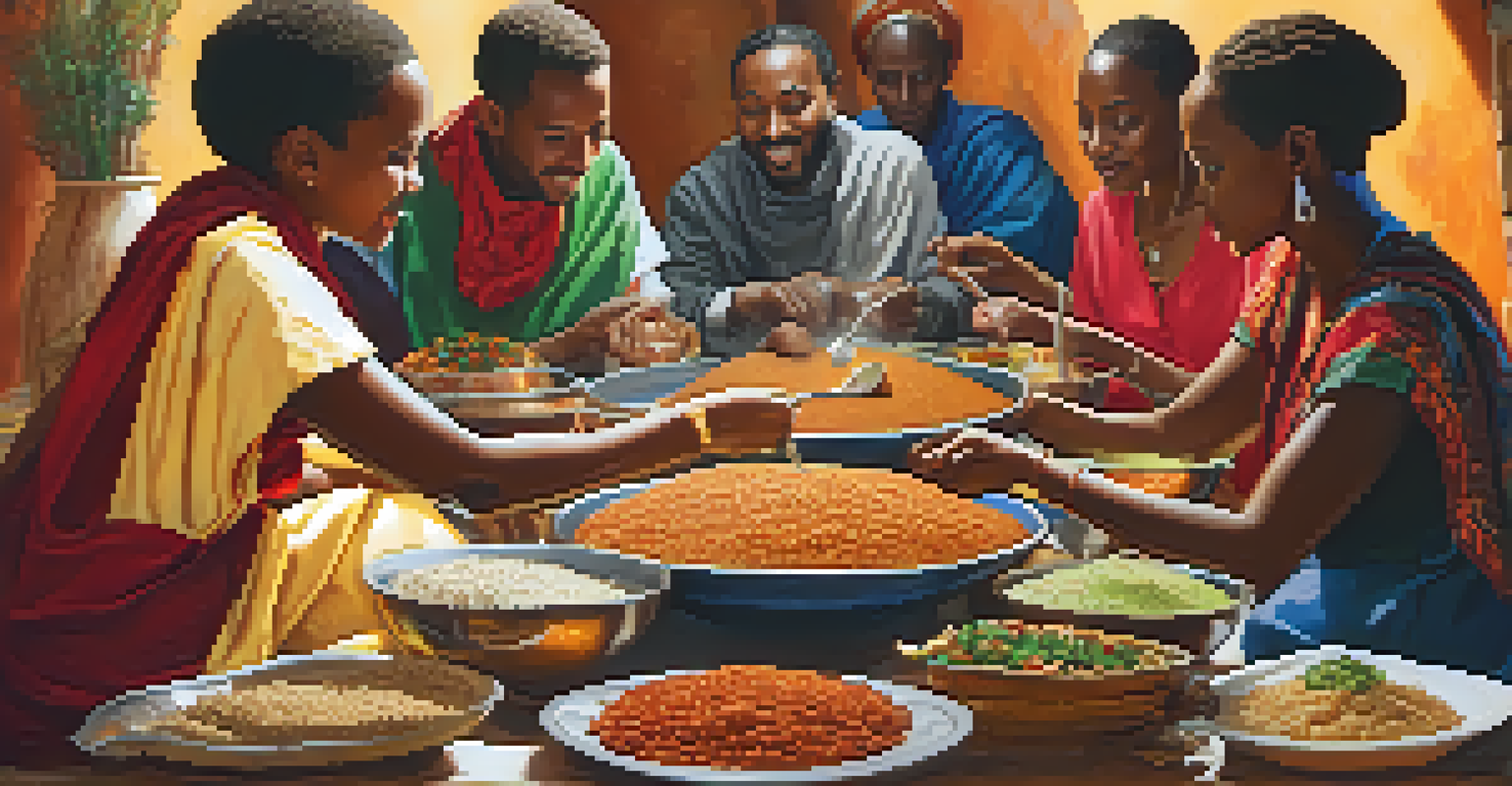Essential Travel Etiquette: Navigating Cultural Norms Abroad

Understanding Cultural Differences in Travel Etiquette
Traveling to a new country is like opening a book filled with different stories, each reflecting its unique culture. Understanding these cultural differences is vital to ensure respectful interactions with locals. For instance, in Japan, bowing is a common greeting, while in the Middle East, a handshake is often preferred. Being aware of these nuances helps travelers avoid unintentional faux pas.
Traveling – it leaves you speechless, then turns you into a storyteller.
It's essential to do a bit of research before your trip. This could mean looking up local customs or even watching a few videos on cultural practices. Knowing whether it's polite to remove your shoes before entering someone's home can save you from an embarrassing situation. These small gestures show respect and appreciation for the culture you’re visiting.
Remember, being open-minded and adaptable is key. If you encounter a cultural norm that seems unusual to you, try to embrace the experience rather than resist it. The more you engage with and respect local customs, the richer your travel experience will be.
Greeting Etiquette: How to Say Hello Around the World
A simple hello can vary greatly from one culture to another. In some countries, a warm handshake is standard, while in others, a kiss on the cheek is customary. For example, in France, it’s common to greet friends with a light kiss on both cheeks, whereas in the U.S., a friendly smile and handshake may suffice. Understanding these differences can set the tone for positive interactions.

Moreover, body language plays a crucial role in greetings. In many Asian cultures, maintaining a respectful distance is part of the greeting process. Conversely, in Latin American countries, a closer proximity may be seen as warm and inviting. Being mindful of personal space can help you navigate these social nuances effectively.
Cultural Etiquette Enhances Travel
Understanding local customs and practices fosters respectful interactions and enriches the travel experience.
If you're unsure how to greet someone, a polite smile can go a long way. Observing how locals interact with each other is a great way to pick up on the appropriate etiquette. Remember, the intent behind your greeting is what matters most, so approach each situation with kindness and curiosity.
Dining Etiquette: Table Manners Across Cultures
Dining is not just about food; it's a reflection of cultural values and traditions. In some cultures, finishing every last bite on your plate is a sign of appreciation, while in others, leaving food can indicate that you’ve had enough. For example, in China, it’s customary to leave a bit of food to show that your host has provided enough. Understanding these dining norms can enhance your meal experience.
The world is a book, and those who do not travel read only one page.
Additionally, the way you use utensils can vary significantly. In many Western countries, using a knife and fork is standard, but in Ethiopia, eating with your hands is the norm. Participating in local dining customs, like sharing food from a communal plate, can be a beautiful bonding experience with locals.
Don’t hesitate to ask for guidance if you’re unsure about the dining etiquette. Most locals will appreciate your effort to understand their customs. Engaging in the local dining practices not only shows respect but also enriches your culinary adventure.
Dress Codes: Appropriate Attire for Different Cultures
What you wear can speak volumes about your respect for a culture. In many Muslim-majority nations, modest clothing is expected, while in more liberal countries, casual dress may be perfectly acceptable. For example, when visiting a temple in Thailand, it’s important to cover your shoulders and knees to show respect. Adapting your attire shows cultural sensitivity.
Researching dress codes before your trip can help you pack appropriately. Understanding the significance of clothing in different cultures can also deepen your appreciation for local traditions. Some cultures have specific colors that symbolize different meanings, and wearing them can indicate respect or celebration.
Respect Local Greetings and Norms
Being mindful of how to greet and behave in different cultures can lead to more positive and meaningful connections.
Ultimately, dressing appropriately is about showing respect for local customs and traditions. If you’re ever in doubt, opt for more modest clothing and observe what the locals wear. This small effort can go a long way in building positive relationships with those you meet during your travels.
Photography Etiquette: When to Snap and When to Ask
Capturing memories through photography is a beloved travel activity, but it’s crucial to respect the privacy of others. In some cultures, taking photos of individuals, particularly in rural areas, requires permission. For instance, in parts of India, asking for a person's consent before snapping a picture is a sign of respect. Always be mindful of local customs regarding photography.
Some religious sites may have strict rules against photography, while others may allow it but with certain restrictions. For example, in many temples around the world, flash photography is prohibited. Doing a little research ahead of time can help you avoid inadvertently upsetting locals.
When in doubt, simply ask before taking a picture. Most people appreciate the gesture and will be happy to pose for you. Remember, being respectful and considerate while capturing your travels will not only make for better photos but also create lasting connections.
Tipping Tips: Understanding Gratuity Around the Globe
Tipping can be a confusing aspect of travel, as customs vary widely from country to country. In the U.S., a tip of 15-20% is standard, while in Japan, tipping can be considered rude. Understanding these differences can help you navigate social norms and avoid awkward situations. For instance, in some European countries, service charges are included in the bill, making tipping less necessary.
Before you travel, it’s a good idea to research the tipping culture of your destination. This can save you from over-tipping or under-tipping, both of which can send unintended messages. Knowing when and how much to tip can also reflect your appreciation for good service.
Language Efforts Build Connections
Learning basic phrases in the local language demonstrates respect and can significantly enhance your travel interactions.
If you're ever uncertain, observing what others do can guide you in the right direction. A smile and a simple thank you can also go a long way in expressing gratitude, whether or not you choose to tip. Ultimately, being aware of local tipping customs demonstrates your respect for the culture.
Public Behavior: Social Norms to Keep in Mind
How you conduct yourself in public can vary in significance from culture to culture. In some regions, being loud or boisterous might be seen as fun, while in others, it can be interpreted as disrespectful. For instance, in many Asian countries, maintaining a calm and quiet demeanor is preferred. Being aware of these social norms can help you blend in more harmoniously.
Additionally, gestures that seem innocent in one culture may have different meanings in another. For example, the thumbs-up gesture is considered positive in many Western cultures, but can be offensive in parts of the Middle East. Learning about local customs can help you avoid misunderstandings and foster positive interactions.

When in doubt, observe how locals behave and adjust your actions accordingly. A little humility and willingness to adapt can lead to more authentic experiences. Respecting public behavior norms not only enhances your experience but also reflects your appreciation for the culture.
Language: The Importance of Communication and Respect
Language is a vital part of culture and can greatly influence your travel experience. While English is widely spoken in many tourist areas, learning a few basic phrases in the local language can show respect and effort. Simple greetings like 'hello' or 'thank you' can open doors and create goodwill with locals. It’s often the thought that counts, and this small effort can be greatly appreciated.
Using the local language can also enhance your interactions. It shows that you are making an effort to understand and connect with the culture. Even if you stumble over the words, locals will likely appreciate your attempt and respond positively.
If language barriers arise, don’t hesitate to use non-verbal communication like gestures or facial expressions. Being patient and understanding helps bridge the gap. Ultimately, fostering communication through respect and effort can lead to unforgettable experiences during your travels.